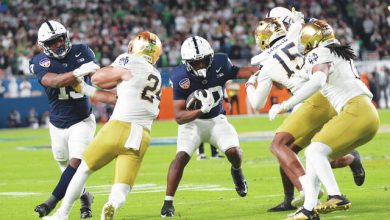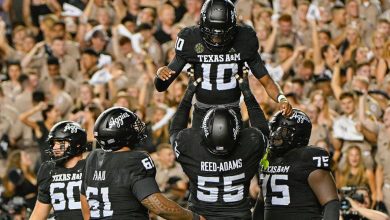Take a look back at some of the best moments from John Stallworth’s Hall of Fame career

John Stallworth’s Hall of Fame career is a testament to the excellence, determination, and class that define the Pittsburgh Steelers’ legacy. One of the most iconic wide receivers in NFL history, Stallworth played his entire career with the Steelers, from 1974 to 1987, and helped define an era of dominance for one of the league’s most storied franchises. A key part of the team’s four Super Bowl titles in just six years, Stallworth’s exceptional skill set, clutch performances, and unwavering consistency have secured his place among the greatest players to ever suit up for the Steelers. As we look back on Stallworth’s legendary career, it’s clear that his influence extended beyond just his on-field statistics—he was the epitome of a professional and a player who stepped up when it mattered most.
Born on July 15, 1952, in Tuscaloosa, Alabama, John Stallworth was a standout athlete from a young age. He excelled in both football and basketball during his high school years before choosing to attend Alabama A&M University. At Alabama A&M, Stallworth’s rare combination of size, speed, and agility made him a dominant force on the football field. His impressive college career earned him the attention of NFL scouts, and in 1974, he was selected by the Pittsburgh Steelers in the fourth round of the NFL Draft.
When Stallworth was drafted, few could have predicted that he would eventually become one of the league’s most prolific wide receivers. The Steelers, led by head coach Chuck Noll, were beginning to build the team that would go on to dominate the NFL through the 1970s and early 1980s. Despite having two future Hall of Famers, Franco Harris and Terry Bradshaw, as the cornerstones of their offense, Pittsburgh’s passing game was still in its formative stages when Stallworth arrived.
Stallworth’s first few seasons in the NFL were marked by steady development, and by his third year (1976), he was beginning to come into his own as a key piece of the Steelers’ offense. The team, which had already won its first two Super Bowls in 1974 and 1975, was now looking to repeat its success in the mid-to-late 1970s, and Stallworth became an integral part of the puzzle. The Steelers’ offense was predicated on balance, combining the power running game of Franco Harris with the deep passing attack orchestrated by Terry Bradshaw. While Lynn Swann often got the majority of the headlines at wide receiver, it was Stallworth who often made the critical plays in big moments.
One of the hallmarks of Stallworth’s game was his ability to stretch the field. Stallworth’s speed and athleticism allowed him to beat defensive backs deep down the field, and his natural hands made him one of the best deep-threat receivers of the 1970s. His partnership with Bradshaw formed one of the most dynamic quarterback-wide receiver duos in NFL history. The Steelers’ passing game, while often overshadowed by their dominant defense—known as the “Steel Curtain”—became a lethal weapon with Stallworth and Swann as the primary targets. Stallworth was consistently able to make big plays when his team needed them the most.
One of his most notable contributions during this period came during the Steelers’ historic 1978 season, when they captured their third Super Bowl title. Stallworth had a standout year, finishing with 1,016 receiving yards and 11 touchdowns, marking the first time he reached the 1,000-yard mark in a season. The Steelers’ offense became more dynamic as Bradshaw found a deep connection with Stallworth, whose speed made him a threat on almost every pass.
Although Stallworth’s career is filled with incredible moments, one of his most significant and defining performances came in Super Bowl IX, which took place on January 12, 1975. The Steelers faced off against the Minnesota Vikings in a game that would ultimately cement Pittsburgh’s status as an emerging powerhouse in the NFL. Although Super Bowl IX is often remembered for the Steelers’ dominant defense—led by players like “Mean” Joe Greene and Jack Lambert—Stallworth’s contributions to the victory cannot be overlooked.
While the Steelers’ offense struggled in the early stages of the game, Stallworth played a pivotal role in helping the team secure the win. In the first quarter, Stallworth caught a 4-yard touchdown pass from Bradshaw, marking his first-ever Super Bowl touchdown. His ability to find space in the end zone and come down with the catch was a crucial moment in a game that saw the Steelers’ offense grind out points against a tough Vikings defense. Stallworth’s touchdown, combined with the Steelers’ staunch defense, gave the team a 16-6 victory and earned them their first Super Bowl championship in franchise history.
This victory was especially meaningful for Stallworth, as it was not only the culmination of a season where he had shown flashes of his potential, but also the beginning of a dynasty that would define his career. As the Steelers continued to win championships, Stallworth would play an increasingly pivotal role in their success, becoming one of the NFL’s premier wide receivers.
Stallworth’s playoff performances were often marked by clutch moments that defined the Steelers’ dynasty. One of the most memorable of these came in Super Bowl XIII, which pitted the Steelers against the Dallas Cowboys on January 21, 1979. This game is widely considered one of the greatest Super Bowls ever played, and Stallworth’s performance was a key factor in the Steelers’ thrilling 35-31 victory.
The game featured two high-powered offenses, but it was Stallworth’s ability to make plays under pressure that set him apart. Stallworth finished the game with 3 catches for 115 yards and 2 touchdowns—one of the defining performances of his career. His first touchdown came in the second quarter on a 75-yard bomb from Bradshaw, a play that showcased his ability to get behind the defense and make a big play in a clutch moment. Stallworth’s second touchdown was a 28-yard grab late in the third quarter, providing the Steelers with a critical lead as the game remained close.
What made Stallworth’s performance particularly remarkable was the context. With the game on the line, Stallworth consistently rose to the occasion, providing Bradshaw with a reliable target and helping the Steelers capture their third Super Bowl in six years. His performance in Super Bowl XIII is still regarded as one of the best by any wide receiver in NFL history, and it solidified his place as one of the premier players of the 1970s.
Even as the Steelers transitioned into the 1980s and faced the challenge of replacing key players from their Super Bowl teams, Stallworth remained a consistent and highly productive wide receiver. Although the team’s championship window began to close, Stallworth continued to be a reliable option for Bradshaw and, later, for quarterback Mark Malone. While injuries began to slow him down in the early part of the decade, Stallworth’s ability to maintain a high level of play despite the physical wear and tear of the NFL is a testament to his work ethic and professionalism.
In 1984, Stallworth had one of his most productive seasons, finishing with 1,149 receiving yards and 6 touchdowns, his best season since 1979. At the age of 32, Stallworth still had the ability to stretch the field and make big plays, and his leadership continued to be invaluable to the Steelers’ offense. His contributions during this period ensured that the Steelers remained competitive, even as other teams in the AFC began to emerge as contenders.
John Stallworth’s career spanned over a decade and included countless unforgettable moments, but it wasn’t just his Super Bowl victories and clutch performances that earned him a spot in the Pro Football Hall of Fame. It was his consistency, his ability to rise to the occasion, and his unmatched work ethic that solidified his legacy as one of the best wide receivers to ever play the game. Stallworth’s career numbers—537 receptions, 8,723 receiving yards, and 63 touchdowns—are impressive, but they don’t tell the full story of his impact on the game.
Stallworth was inducted into the Pro Football Hall of Fame in 2002, a well-deserved honor that recognized his contributions to the Steelers’ dynasty and his excellence as a wide receiver. He was a four-time Super Bowl champion, two-time Pro Bowler, and one of the most respected players of his era. His ability to perform in big moments, particularly in Super Bowls XIII and XIV, made him a Hall of Famer not just for his statistics, but for his ability to change the course of games when it mattered most.
His induction into the Hall of Fame was not just a recognition of his individual accomplishments, but a tribute to the era of football he helped shape. Stallworth was part of the Steelers’ team that defined the 1970s and created a blueprint for sustained success in the NFL. His contributions were integral to the Steelers’ success, and his legacy is intertwined with the franchise’s greatness.
John Stallworth’s career is a story of determination, excellence, and championship pedigree. As one of the NFL’s premier wide receivers in the 1970s and 1980s, Stallworth set the standard for what it means to be both a clutch performer and a model professional. Whether it was his deep connections with Terry Bradshaw, his consistency as a pass-catcher, or his ability to make critical plays in the postseason, Stallworth’s legacy is undeniable.
From his early days with the Steelers to his final seasons, Stallworth was a central figure in one of the most successful periods in NFL history.
His Hall of Fame career is a fitting tribute to his hard work, talent, and the invaluable contributions he made to the Pittsburgh Steelers’ dynasty. As fans look back on the golden years of Pittsburgh football, Stallworth will forever be remembered as one of the key pieces in the team’s four-championship run and one of the NFL’s greatest wide receivers of all time.









